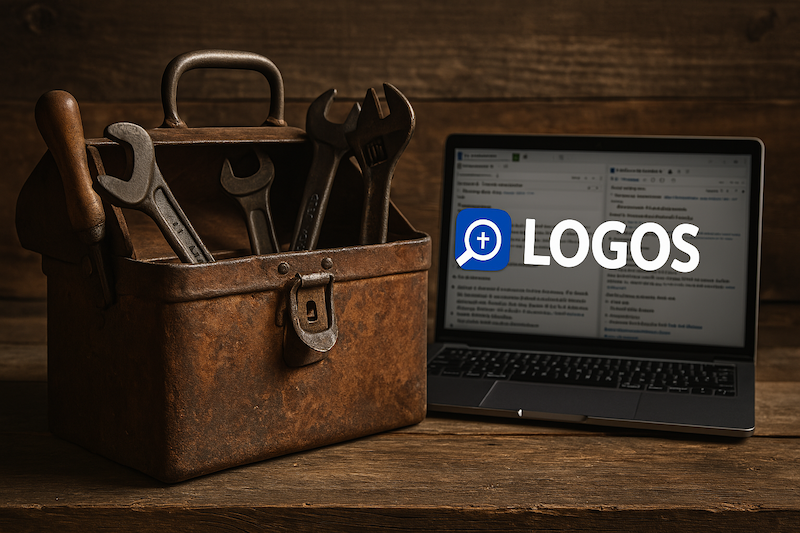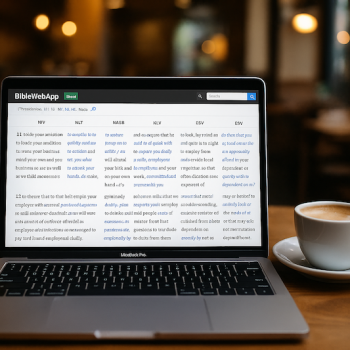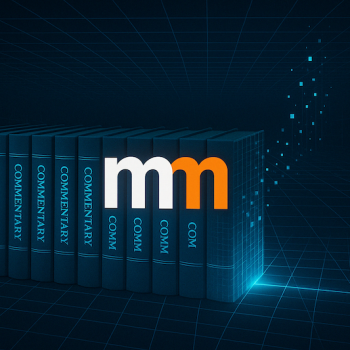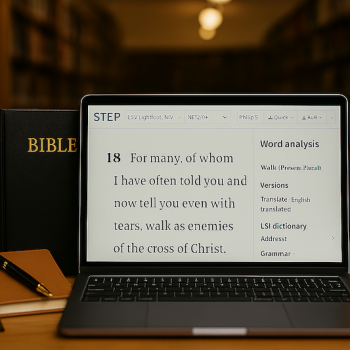
In my journey to lead a quieter life—one rooted in simplicity, depth, and thoughtful faith—I commit a lot of time to study and grow. Over the years, I have had to rethink how I study and grow based on the season I am in. As a pastor and student, I’ve always loved sitting with a physical book and experiencing the book, but recently, I found myself leaning more toward new and digital resources than ever before. In the next few blog posts, as part of the Bible Study Essentials series I am blogging through, I am exploring digital resources that I find myself inseparable from. The Bible Study Essentials series will explore those online and digital resources that help me to study and grow. I hope that through this series, you will find some resources that will help you study and grow to better lead a quiet life that is rooted in simplicity, depth, and thoughtful faith.
First, in this Bible Study Essentials series, I want to explore Logos Bible Software. Please note that I haven’t been asked to review Logos Bible Software or paid to say any of this, but after a full week of using it heavily for sermon prep, academic writing, and personal study, I knew I wanted to start this resource series on sharing my experience with Logos. Logos Bible Software has become more than just a tool; it’s a quiet companion that fits the rhythm of a slower, more intentional life of faith focused on study and growth. Through this post, if you aren’t using Logos, I hope you will consider it. In the least, I would encourage you to just explore Logos for yourself. Through this personalized link, you can download a free book from Logos and try the free version.
My Introduction to Logos Bible Software
I’ll be honest – it took me a while to warm up to Logos Bible Software. I am someone who loves the feel of a real book in my hands. The smell of paper, the texture of a page, the beauty of the binding, and the experience of reading with the right setting, light, chair, and cup of coffee — reading has always been an experience for me. Sure, I own books on the Amazon Kindle app, Apple’s Books app, and other digital platforms and PDFs. However, none of these offer the same romanticized, nostalgic experience that a printed book does.
For many years, I collected books that made up my own library. At one point, I had nearly 3,000 books in my collection. That may be small compared to some pastors or professors, but it was a collection I regularly studied, sat with, paged through, and referenced. Those books felt like an extension of who I am and what influenced me. One of the churches I had pastored in had custom-built shelves wrapping around two walls of my large office. I filled them with the books that I collected, books that I knew and loved — commentaries, theology, church history, and practical ministry guides. When someone first recommended Logos, I gave it a try. I downloaded some free books and added a few here and there. However, I did not love it. To me, at the time, it felt slow, clunky, and cold (reading without the experience). It wasn’t the reading experience I was used to, and I knew that building my collection would be an investment.

A Professor’s Recommendation Changed My Perspective
That started to shift during seminary. Fuller Seminary remarked that it would be good to have a bible study software. Many other professors made remarks like this in passing. However, for the most part, I continued to invest in books in print that I found used and through sales. While I was studying for my first master’s degree in Theology and Ministry at Fuller Seminary, I had a class on the parables of Jesus that was taught by Dr. David Parris. Parris is an Adjunct Associate Professor of the New Testament and runs a YouTube channel called The Caffeinated Bible, where he extends academic learning beyond the four walls of seminary. His research and work are well known. Early on in his course, Dr. Parris convincingly and constantly emphasized the importance of having good Bible study software for our studies.
Even though he personally used Accordance (I believe that is what he utilized), Dr. David Parris acknowledged that Logos was a solid choice. I believe he even said that he wasn’t so invested financially in his current software; he might have gone with Logos because of their many new features. I recall his remarking that the best software, is the one you are using and is updated with manuscripts and newer research and commentaries. My professors’ encouragement, along with the practical reality that I needed books that could travel with me and be more diverse than I could own in print, pushed me to give Logos another try. At the time, the church I was pastoring in offered a $1,000-per-year resource fund for continuing education and study materials. I started to use that to purchase Logos books, especially commentaries and theological works. Over time, as my library grew and the diversity of my collection grew, I continued to notice that my view of Logos changed.
Dr. David Parris has some YouTube Videos on The Caffeinated Bible show that are worth watching on the importance of having software for study. You might enjoy – Strong’s Concordance VS Software! The Ultimate Showdown, The Best Free Bible Software?, Bible Study Hack 2: Bible Software, Should You Buy Bible Software?, and How Much Do You Need to Spend $$$ on Bible Software?.
When I Changed Careers, Logos Became Essential
In 2020, I transitioned out of a pastoral role I had been in for seven years. That meant I had to give up my office — and with it, my beloved bookshelves that housed my growing libary. I didn’t have space at home for even a third of my book collection in my home office. Most of my books went into storage bins. Truthfully, five years later, many are still on temporary shelves and stacked on the floor in my home office. Though a few book collections came with me to my new office at Water Street Mission, where I now serve people experiencing homelessness, I knew I wasn’t going to haul my collection in and out. Plus, as a pastor in two contexts (Water Street Mission and River Corner Church), it made sense to have most of my collection at home where they could be accessed for my work as a church pastor as well. In this change of peace, I noticed that Logos Bible Software suddenly became a necessity. I needed a way to access scripture, commentaries, and theological resources from my phone, laptop, or wherever I was. Logos filled that gap. Over time, I got better at reading digitally. While print is still my preferred format, I’ve come to love the portability, depth, diversity, and power of Logos Bible Software.
My Logos Library Today
I now have nearly 3,000 resources in my Logos library (I am four or five books short of 3,000). My collection includes 593 ancient manuscripts, 546 biblical commentaries, over 195 Bible translations, over 25 Systematic Theology books, and countless others. I have especially enjoyed the access to early church fathers like Origen and Augustine, scholars like J.B. Lightfoot, and modern voices in biblical studies from Keener to Moo— all at my fingertips. As a pastor, doctoral student studying the Lord’s Prayer at Kairos University, and regular preacher at River Corner Church, this has become invaluable to my sermon messages, answering questions in pastoral care sessions, and theological research for my dissertation. Currently, I am on the Max Subscription plan and have purchased some basic libraries over the years, but I have not invested in a specific customized library collection yet through Logos.
Why I Love Logos Bible Software
Just this week, while preparing a sermon, I realized again how much I rely on Logos and how much I love the diversity of my collection in planning a message. In preparation for a message on Philippians 3, I was able to reference more than fifteen commentaries and dozens of historic sermons and explored Greek usage of Paul’s use of the verb χαίρω throughout his Philippian epistle. Even more, Logos allowed me to copy quotes with automatic Turabian-style footnotes into my sermon manuscript and recent doctoral research (you can customize citation style too!), which I just love. The ease of searching the original languages easily, comparing translations quickly, and accessing linked resources with a simple click is unmatched in preparation. To top it off, I can use my library anywhere — from the office, home, coffee shop, or even in a meeting. I truly believe that the software has also become faster and more user-friendly over the years. What once felt bulky now feels smooth and intuitive.
The Subscription Model: A Bittersweet Shift
When Logos shifted to a subscription model, I was initially skeptical. It felt like another consumeristic ploy. However, with an academic discount and an early deal, I got a two-year Max Subscription for under $100 — and it ended up being more than worth it. In addition to purchasing individual books, library collections, and more – you will find that Logos now offers different subscription levels – The Premium level is good for for small group leaders and personal study, the Pro level is a good option for pastors and general sermon prep, and the Max level is perfect for deep language study and academic research. You will still want to add your own book collections and resources to make Logos custom to your work and context.
There are a lot of features within Logos that many find helpful, too. For me, it’s not the features so much as there are many I have never used — it’s the books and linked resources that are optimized for use in the program. One benefit to using Logos is also that Logos adds free books monthly that you can simply just add to a free plan and build your library slowly and simply, and when you are ready you can take advantage of the the subscription level that matches your ministry and you will find with it a collection of books that includes hundreds more. Students, academic pricing is something to certainly take advantage of (you will have to renew it every six months, but it is easy to do so). You will find that seasonal sales make it easier to build your library without breaking the bank.
The Drawbacks
Logos isn’t cheap. Some commentary sets, like The New Interpreter’s Bible, which I have in print but not yet digitally, are still just under $600 — even with discounts. And yes, I’m now deeply invested in Logos. I’ve spent close to $1,000 on resources. If Logos were ever to shut down or lose prominence, it’d be a real blow. But they’ve been around since 1992, and they show no signs of slowing down. This feels like a good time to mention that Logos Bible Software was founded in 1992 by Bob Pritchett, his father Dale, and Kiernon Reiniger after leaving their jobs to create Christian software. Since then, it’s become part of the Faithlife Family and grown into the leading Bible study platform trusted by pastors, scholars, and students around the world. Many seminaries insist on it and even give you access to libraries that they have customized. With over three decades of innovation, a solid track record, and remarkable partnerships, it’s safe to say that Logos isn’t going anywhere anytime soon. Still, be aware that the investment is real — financially and practically.
Final Thoughts: Is Logos Worth It?
If you’re a pastor, seminary student, or serious Bible nerd, Logos is worth it. It took me a minute to get used to it, and now I cannot imagine a minute without it. Even if you’re just curious, there’s a free version you can try. The free version of Logos includes helpful tools like Bible Word Study, basic study workflows, a limited version of Factbook, and several free books to get you started. And no, you won’t lose access to any books you’ve purchased if you cancel your subscription. The free books are always free and yours. Anything you buy is yours to keep, forever. I haven’t gotten rid of my physical book collection yet, though it’s been trimmed down. There are still times for the experience of reading. However, Logos is still right on par with my physical library, and maybe even referenced more.
Why I Recommend Logos
I love and recommend Logos Bible Software because it gives me instant access to thousands of biblical resources, ancient texts, and commentaries—anytime, anywhere. As a pastor, student, and lifelong learner, it’s become an essential tool for sermon prep, academic writing, and personal study. I can explore original languages, reference church history, and study scripture in depth, all from my laptop or phone. The automatic footnotes, linked resources, and growing digital library have made Logos far more than just software—it’s become my go-to study companion and a vital part of my ministry and learning rhythm.
If you’re looking for a powerful, professional, portable library to support your ministry or studies, give Logos Bible Software a try. It might just change how you study scripture. As I said earlier, I would encourage you to just explore Logos for yourself. Through this personalized link, you can download a free book from Logos and try the free version.
This post kicks off my Bible Study Essentials series with a closer look at Logos—not because I was asked or paid to, but because I use it regularly. Logos has become more than just software; it’s a quiet companion that fits the pace of a slower, more intentional life of faith. If you’re not already using it, I hope you’ll consider exploring what it has to offer.

















